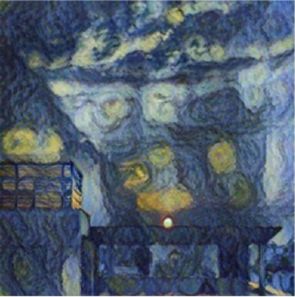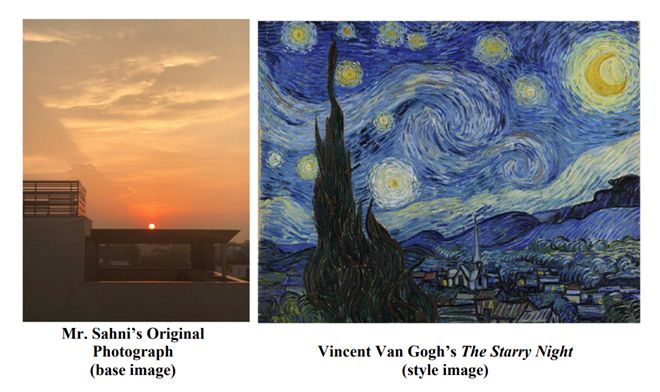Last Fall in this space, we discussed the U.S. Copyright Office's AI Initiative launched in early 2023. Among other things, the Initiative's portal compiles registration decisions for AI-generated materials. Particularly instructive is a December 11, 2023 decision by the Copyright Review Board affirming the denial of registration to an AI-generated artwork. As detailed below, when determining the copyrightability of the "SURYAST" work, the Review Board provides practitioners and future applicants with more articulated standards to be applied when a party seeks to register a work that contains AI-generated content.
Background of Work
"SURYAST" is reproduced in the decision and depicts a modern home rendered in the style of Vincent van Gogh's, The Starry Night:

The applicant, Ankit Sahni, in his December 1, 2021 application, listed himself and the "RAGHAV Artificial Intelligence Painting App" ("RAGHAV") as authors. He described RAGHAV as an "assistive software tool" through which he, as the author, controlled creative decisions by selecting the original photo, determining the style input, and setting the variable value for the amount of "style transfer" from one of the pictures (the "style picture") to another image (the "base picture"). The below images are the "base image" (a photograph taken by Mr. Sahni) and the "style image" (Vincent Van Gogh's Starry Night):

As the decision highlights, the applicant described RAGHAV as not simply layering the style image on top of the base image like a visual filter applied to a photograph, but rather, the tool "generates" a new image altogether based on the features it learns from the base photograph and the style image. The decision notes also that Mr. Sahni did not claim to have modified the work after it was generated.
Mr. Sahni did not claim any authorship over the development of the RAGHAV tool. Thus, the Board did not consider the selection of the materials that RAGHAV was trained on or its development as bases for creative control over the Work and saved that issue for another day and decision.
History of Proceedings
The Copyright Office declined to register the work in June 2022, and upon a request for reconsideration, affirmed its denial, concluding that the "work deposited . . . does not contain enough original human authorship to support a registration." In a letter dated July 10, 2023, Mr. Sahni asked the Office to reconsider yet again, focusing on how, despite the use of the AI tool, he met many of the traditional elements of human authorship necessary for a copyright. As discussed in greater detail below, the Board, in its December 11, 2023 decision, disagreed and declined to register the work.
The Work Does Not Contain Sufficient Human Authorship to Qualify for Copyright Protection
In a thorough decision outlining the reasons for the denial of registration, the Board begins by highlighting the federal district court decision last year in the case of Thaler v. Perlmutter denying registration to "A Recent Entrance to Paradise," a fanciful image produced entirely by an AI system. Thaler establishes the principle that "human authorship is a bedrock requirement of copyright." The Office further relies on the 9th Circuit's 2018 decision in Naruto v. Slater, the memorable case holding that copyright does not protect photographs taken by a monkey because human, not animal, authorship is required under the Copyright Act.
The decision then gives an overview of the current Copyright Office approach to AI-generated works, including its March 2023 guidance document pursuant to which it will analyze whether a work is "actually conceived and executed not by man but by a machine." In other words, the Office's position is that a work containing AI-generated content may be copyrightable but that this is a "case-by-case" analysis that will "depend on the circumstances, particularly how the AI tool operates and how it was used to create the final work."
Under these standards, Mr. Sahni argued that his creative control over the ultimate image resulted in the Work containing "1) 'a sunset,' 2) 'clouds,' 3) the 'contours of a building,' 4) 'a composition in which 'the sky accounts for the upper two thirds of the work,'' and 5) 'a precise and deliberate style of Van Gogh's [The] Starry Night.'"
The Board rejected Mr. Sahni's argument and concluded that the work is not the product of human authorship because Mr. Sahni did not provide "the expressive elements of pictorial authorship." Indeed, RAGHAV, not the applicant, controlled the placement of picture elements (i.e., the sun and clouds) and the colors that would be applied to them. As the Board explains:
The fact that the Work contains sunset, clouds, and a building are the result of using an AI tool that "generate[s] an image with the same 'content' as a base image, but with the 'style" of [a] chosen picture." But Mr. Sahni did not control where those elements would be placed, whether they would appear in the output, and what colors would be applied to them—RAGHAV did.
(Citations omitted.) The Board also disagreed with Mr. Sahni's comparison of RAGHAV to photo-editing software like Adobe's Photoshop product. In contrast to photo-editing software which the user controls, RAGHAV operates by "generating" a whole new pictorial image based on features learned from user-provided images. Specifically, the Board noted that Mr. Sahni conceded he only offered three inputs: (1) the base image, (2) the style image, and (3) a numerical value that represents the degree of style to be transferred. Thus, the Board found that "[b]ecause Mr. Sahni only provided these three inputs to RAHGAV, the RAGHAV app, not Mr. Sahni, was responsible for determining how to interpolate the base and style images in accordance with the style transfer value. In other words, it is the AI model and not the user who makes creative decisions. The Board viewed the selection of a numerical variable for the "'strength' of the style" as "the kind of de minimis authorship not protected by copyright."
Key Takeaways
In its decision, the Board hewed closely to the human authorship requirement set forth in Thaler and Naruto. It draws a clear line between, on the one hand, an applicant making stylistic edits in photo-editing software to a photograph they took, versus an applicant simply running that same photograph through AI software that itself generates an entirely new image. While in both instances a new image results vis-à-vis the original photograph, in the former scenario, the user is the one making the creative decisions demonstrating human authorship, whereas in the latter, the software makes those decisions.
In the future, if an AI system were to allow for more control over composition and color, or if the style inputs were the artist's own works, there may be a better argument for copyrightability. The key factor that the Board focused on in this case was the fact that the AI software "generated" a new image and that the degree to which the "style image" changed the "base image" was controlled by the AI and not the human—other than the de minimis selection of a numerical value of transfer between 1 and 10.
Another future scenario prompted by this decision is where the applicant develops the image-generating software. Indeed, the decision mentions that there was nothing in the record indicating that the RAGHAV app was created by the applicant. In other words, where the author creates the software, they likely can show more "control" over how the software manipulates and changes images. While we do not know if the result would have been different, we can envision a case where the applicant designs the software and codes it to reflect a certain design aesthetic. From a human authorship perspective, that would arguably be more akin to using photo-editing software to modify a raw image.
We will monitor any further developments in this case and will keep an eye out for other unique cases that are sure to arise in the AI space.
The content of this article is intended to provide a general guide to the subject matter. Specialist advice should be sought about your specific circumstances.


